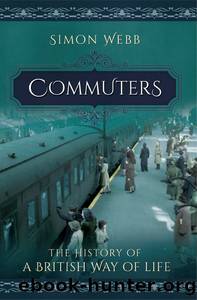Commuters by Simon Webb

Author:Simon Webb
Language: eng
Format: epub
Tags: TRANSPORTATION / Railroads / General
ISBN: 9781473862920
Publisher: Pen & Sword Books
Published: 2016-10-14T00:00:00+00:00
Chapter 7
Beneath the Earth: The First Underground Trains
We sometimes assume that congested city streets and gridlocks are somehow associated with what used once to be referred to facetiously as the âinfernal combustion engineâ. In other words, it looks to us today as though cars are the root cause of traffic problems in British cities and that if a magic wand could be waved and all the petrol driven vehicles made to vanish in the twinkling of an eye, then our streets would become pleasant and relaxing places to be. Nothing could be further from the truth and a quick look at the situation in the capital during the High Victorian period of the mid-nineteenth century will show us why.
In June 1855, the Parliamentary Select Committee on Metropolitan Communications was sitting in London. They hoped to find some radical way of easing the chronically clogged condition of Londonâs streets. Joseph Paxton, designer of the Crystal Palace, Liberal MP and one of the foremost architects of the day, was summoned to give evidence about the nature of the problem. Paxton told the committee that it was quicker to travel by train from Brighton to London Bridge Station than it was to go through London by road from London Bridge to Paddington Station. Now thatâs congestion!
Of course, all the traffic on the roads at that time was drawn by horses and much of it was commercial; carts delivering fresh produce, brewersâ drays, wagonloads of hay to feed the horses stabled in London and a hundred other kinds of horse and cart carrying out the routine and commonplace tasks associated with a city of more than two million inhabitants. A large part of the problem, though, was caused by commuters.
The omnibuses introduced in 1829 by George Shillibeer had proved to be phenomenally popular, so much so that the frantic competition had driven him to bankruptcy in less than two years. There had been various attempts to restrict and regulate the number of buses operating in London, but by 1850 there were over 1,300 in London. Until 1832, the centre of London had been the exclusive preserve of Hackney Carriages, but when this ban had been lifted, the West End and City of London soon became full of omnibuses, most of them carrying people to work. Nor were buses the only method of road transport being used by London commuters that were clogging up the roads at that time.
There had been carriages for hire in London since the middle of the seventeenth century. The first Hackney Carriage licences were being issued in 1662; just after the restoration to the throne of Charles II. These vehicles were cumbersome and needed more than one horse to draw them. In 1834, just four years before Victoria came to the throne, a new, lightweight carriage for hire was invented. Joseph Hansom, an architect from York, devised and patented a two-wheeled cab which could be drawn by a single horse and was especially manoeuvrable; a vital quality when moving through the London traffic.
Download
This site does not store any files on its server. We only index and link to content provided by other sites. Please contact the content providers to delete copyright contents if any and email us, we'll remove relevant links or contents immediately.
| Automotive | Aviation |
| History | Mass Transit |
| Owner's Manuals & Maintenance Guides | Railroads |
| Reference | Ships |
Small Unmanned Fixed-wing Aircraft Design by Andrew J. Keane Andras Sobester James P. Scanlan & András Sóbester & James P. Scanlan(32763)
Navigation and Map Reading by K Andrew(5132)
Endurance: Shackleton's Incredible Voyage by Alfred Lansing(4715)
And the Band Played On by Randy Shilts(2163)
The Box by Marc Levinson(1964)
Top 10 Prague (EYEWITNESS TOP 10 TRAVEL GUIDES) by DK(1957)
Wild Ride by Adam Lashinsky(1950)
The Race for Hitler's X-Planes: Britain's 1945 Mission to Capture Secret Luftwaffe Technology by John Christopher(1837)
The One Percenter Encyclopedia by Bill Hayes(1811)
Trans-Siberian Railway by Lonely Planet(1725)
Girls Auto Clinic Glove Box Guide by Patrice Banks(1707)
Bligh by Rob Mundle(1676)
Looking for a Ship by John McPhee(1651)
Good with Words by Patrick Barry(1640)
Batavia's Graveyard by Mike Dash(1632)
TWA 800 by Jack Cashill(1625)
Fighting Hitler's Jets: The Extraordinary Story of the American Airmen Who Beat the Luftwaffe and Defeated Nazi Germany by Robert F. Dorr(1610)
Troubleshooting and Repair of Diesel Engines by Paul Dempsey(1578)
Ticket to Ride by Tom Chesshyre(1567)
